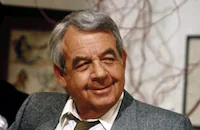Manhattan-born filmmaker Larry Cohen managed to resourcefully overcome a number of obstacles over the course of his career in film and television. He managed to work around permit restrictions, slashed budgets, incomplete scripts and other factors that would deplete the average director’s creative inspiration. After scoring his biggest hit with the public in 1974 with It’s Alive (which in turn spawned two less lucrative sequels), he became firmly identified with the horror and science-fiction genres, something he continued to embrace with films like God Told Me To (1976), The Stuff (1985) and perhaps his most acclaimed film, Q: The Winged Serpent (1982). Even his darkest films were laced with a heavy dose of satirical and very offbeat humor, a trait that came to the forefront with his idiosyncratic horror comedy Full Moon High (1981).
However, one of the biggest projects of his career also turned out to be the one that became the most infamous: Wicked Stepmother (1989). It started as a whimsical supernatural comedy starring Bette Davis as Miranda, a heavy smoking witch who marries Sam (Lionel Stander) while his daughter Jenny (Colleen Camp) is away from home with her husband, Steve (Davis Rasche). Upon returning, Jenny is horrified to find herself in a real-life fairy tale that puts her entire family in peril. Unfortunately, disaster struck when the film began shooting in the Spring of 1988 in Los Angeles, when Davis had to take a break from filming after one week for dental surgery in New York – but she never returned to the set. Accounts differ from that point, with Davis claiming eight months later in the Los Angeles Times that she was displeased with the footage that had been shot: “I’m not a vain person. But at 80 years old I don’t want to look the way I looked. It could seriously be the end of anybody ever hiring me again.”
Cohen’s side of the story begins when he saw Davis presenting at the Golden Globes (most likely the 1986 ceremony), according to a 2012 reminiscence for Film Comment, and he decided to write a part for her that would give her another spot in the limelight rather than being a fixture at award ceremonies. The two hit it off, and he claimed that the dental procedure had a much heavier toll than anticipated that ultimately led to her being unable to return to the production. Davis had made a physically limited but emotionally potent comeback in The Whales of August (1987) by the time the script was done, and she had also published a bestselling memoir, This ‘n That. Though her reps initially passed on the script, Turner Classic Movies’ own Robert Osborne lived in her building and passed it along to her directly. What started off as a harmonious production came to a swift end soon after the camera started rolling, with Davis appearing in TV interviews numerous times over the following year recalling her version of why she left.
In the interim, Cohen did some reshuffling of the film to boost the role of Barbara Carrera, who had initially been cast as Davis’ conniving daughter Priscilla (also a witch). The solution to the film’s sudden, very public problem: turn Carrera into an alternate version of Davis’ character herself, also using cat transformations to rationalize the plot gaps and allow the film to be completed. A veteran of the Cohen-scripted I, the Jury (1982), the Nicaraguan-born actress ended up sharing equal poster space with Davis when the film opened on February 3, 1989, ultimately becoming more of a success on VHS when it hit home video a year later. For movie buffs, the film offered a chance to see Davis on the big screen again and get a chuckle out of a well-timed gag involving a photo of Stander’s previous wife, which we wouldn’t dream of spoiling. Davis would pass away later that same year on October 6, leaving behind a cinematic legacy filled with dramatic real-life twists and turns that, as it turned out, would extend to the film that would ultimately prove to be her swan song.




















